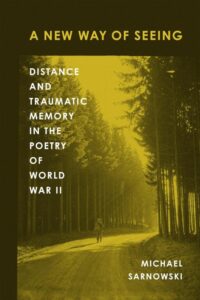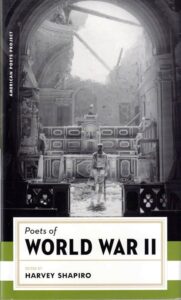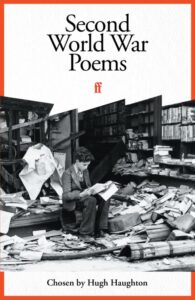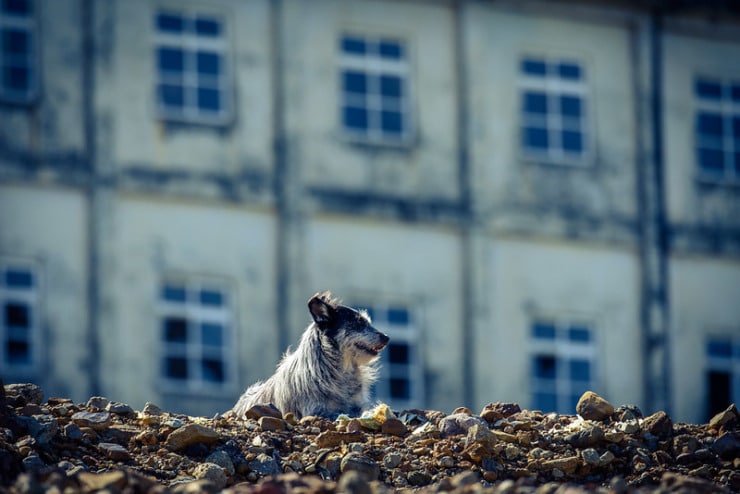
Two anthologies highlight the poets and poetry of World War II
Eighty years ago this month, World War II ended in Europe. Three months later, the atomic bombing of Hiroshima and Nagasaki forced the Japanese Empire to surrender as well. The most destructive war in human history had ended. It was also the deadliest – between 40 million and 50 million people died as a direct result of the war.
The Great War, or World War I, is the war associated with poets. And soldiers and civilians alike wrote write some incredible poetry. The war brought the Victorian and Edwardian world to a close and can be said to have given birth to the Modern period. Poets, especially those in Britain, chronicled the march to war, the horrific battles and trench warfare, and the aftermath that often seemed so hollow. Some of the most beautiful and startling poems in the English language were written during that war, poems like “Dulce et Decorum Est” by Wilfred Owen.
If anything, poetry and its creation were even more present and prolific during World War II, and yet you might be hard-pressed to name a single poem associated with the war. World War II was larger in geographic scope, involved more countries and larger armies, killed more people, and wreaked more destruction, and yet the poetry of the war simply isn’t as well known.
Anthologies have been published over the years since the end of World War II. In fact, a new one, entitled A New Way of Seeing: Distance and Traumatic Memory in the Poetry of World War II by Michael Sarnowski is being published next month. It’s a study of five poets strongly associated with the war. Interestingly enough, none of them is known as a “World War II poet.”

The Shapiro collection includes work by both the lesser known and the better known. Among the 61 poets with poems in the books are Ezra Pound, Robinson Jeffers, Marianne Moore, Yvor Winters, John Berryman, Woody Guthrie, May Sarton, William Stafford, Howard Nemerov, Robet Lowell, and Richard Wilbur. The poems cover the broad range of life during war and life on the home front.
The volume contains many moving poems, but one I found particularly so was this one by John Frederick Nims (1913-1999), published in September 1943.
Shot Down at Night

Arm gold as saddle-leather, lakeblue eyes,
Found in a foreign sky extravagant death.
Dreamy in school,
Parsed tragic Phaethon and heard of war,
Arose surprised, gravely shook hands, and left us.
His name,
Once grey in convent writing, neat on themes,
Cut like erosion of fire the peaks of heaven.
The Arab saw
Strange flotsam fall: the baseball-sounding spring,
The summer roadster, pennoned with bright hair,
The dance at Hallowe’en,
The skater’s kiss
At midnight on the carillons of ice.
In addition to being a poet, with numerous published collections, Shapiro flew 35 missions as an Air Force radio gunner during the war and was decorated for his service. He also was the editor of The New York Times Book Review and The New York Times Magazine. He is credited with suggesting to Martin Luther King that he write an account of his experience in jail, which became “Letter from Birmingham Jail.”
Shapiro arranged the selected poems in his collection mostly chronologically. Hugh Haughton, in Second World War Poems, arranged his selections alphabetically. While British might slightly predominate, the 105 poets include Americans, French, Italians, Germans, Japanese, and several other nationalities. For most of the poems, Haughton gives the approximate date at composition or publication.
At the very beginning of the war, poet Louis MacNeice was living on the northeast cost of County Antrim in Northern Ireland. He composed a sequence of poems, including this one, the title taking from the town where he was renting a house.
Cushendun

Made as it were out of clouds and sea:
All night the bay is plashing and the moon
Marks the break of the waves.
Limestone and basalt and a whitewashed house
With passages of great stone flags
And a walled garden with plums on the wall
And a bird piping in the night.
Forgetfulness: brass lamps and copper jugs
And home-made bread and the smell of turf or flax
And the air a glove and the water lathering easy
And convolvulus in the hedge.
Only in the dark green room beside the fire
With the curtains drawn against the winds and waves
There is a little box with a well-bred voice;
What a place to talk of War.
What a place to talk of war, indeed, a quiet Irish village that seemed very far away from decisions being made in Berlin, London, and Paris.
Haughton, too, includes a wide array of perspectives on World War II, and not only geographic or national ones. The home front is represented, as are battles in both the European and Pacific theaters, the London Blitz, and ultimate victory. Among the poets included are Paul Celan, Bertold Brecht, Elizabeth Bishop, T.S. Eliot, Wallace Stevens, Primo Levi, Czeslaw Milosz, Boris Pasternak, and Dylan Thomas.
Haughton is an Emeritus Professor of Modern Literature at the University of York in England. His books include Sigmund Freud, the Uncanny (2004), The Poetry of Derek Mahon (2007), and, with Valerie Eliot, The Letters of T.S. Eliot Volumes 1 and 2 (2008).
In his introduction to the collection, Haughton points out several reasons why the poetry of the Great War is better known than the poetry of World War II, the most obvious and perhaps most important being that it was a very different kind of war from its predecessor – more globa and more destructive, with political ideologies rather than national ambitions driving it. Still, the war produced some outstanding poetry which deserves to be better known.
Photo by Pai Shih, used with permission of the photographer, via Flickr. Post by Glynn Young.
How to Read a Poem uses images like the mouse, the hive, the switch (from the Billy Collins poem)—to guide readers into new ways of understanding poems. Anthology included.
“I require all our incoming poetry students—in the MFA I direct—to buy and read this book.”
—Jeanetta Calhoun Mish
- “Your Accent! You Can’t Be from New Orleans!” - October 9, 2025
- Poets and Poems: Donna Vorreyer and “Unrivered” - October 7, 2025
- Poet Sidney Lanier and the Lost Cause - October 2, 2025


Sandra Fox Murphy says
I do love this perspective, Glynn. The words from war zones are authentic, emotions and pain etched in a soldier’s or seaman’s bones. I often remember walking through the Nimitz Pacific War Museum with my grandson (in Fredericksburg, Texas) and reading the quoted accounts of war. The young man who described the murky walk chest-high in swamp waters in the heat and humidity of the Philippines, rifle raised high, his despair of the unknown and clouded hope of a tomorrow. Was it all worth it? bold in the blank spaces between lines. Love that you shared this, and we should all listen more keenly to the whsipered words of war poets and storytellers.
Glynn says
Sandra, thanks for the comment. I don’t think we realize how much of an impact World War II had on us. Both my father and father-in-law were in the Navy and involved in the Pacific war. Like the Depression, the war shaped their generation — and us.